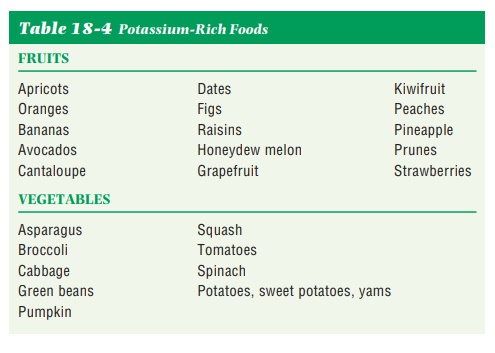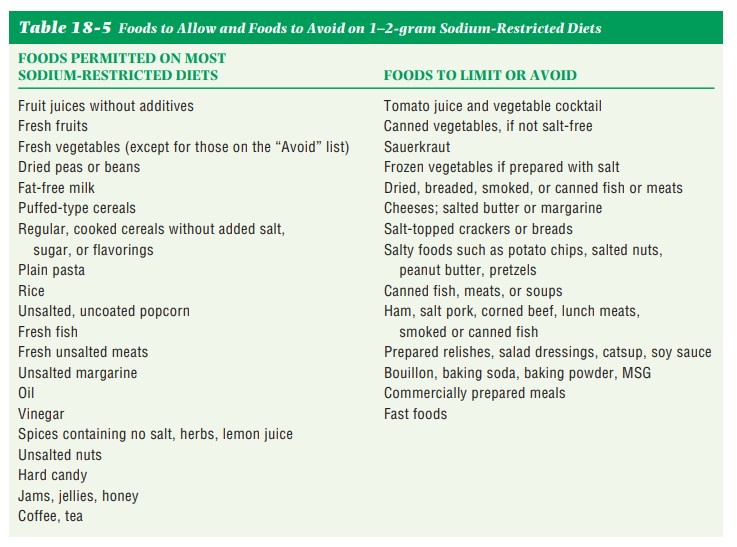Chapter: Nutrition and Diet Therapy: Diet and Cardiovascular Disease
Dietary Treatment for Hypertension
DIETARY TREATMENT FOR
HYPERTENSION
As indicated above,
weight loss for the obese client with hypertension usually lowers blood
pressure, and thus a calorie-restricted diet might be prescribed. A
sodium-restricted diet frequently is prescribed for clients with hypertension.
Certain ethnic groups, such as African Americans with new onset of HTN and
those already diagnosed with HTN, should limit sodium intake to 1,500 mg/day. A
discussion of this diet follows. When diuretics are prescribed together with a
sodium-restricted diet, the client may lose potassium via the urine and, thus,
be advised to increase the amount of potassium-rich foods in the diet (see
Table 18-4).

Sodium-Restricted Diets
A sodium-restricted
diet is a regular diet in which the amount of sodium is limited. Such a diet is
used to alleviate edema and hypertension. Most people obtain far too much
sodium from their diets. It is estimated that the average adult consumes 7
grams of sodium a day. A committee of the Food and Nutrition Board recommends
that the daily intake of sodium be limited to no more than 2,300 mg (2.3
grams), and the Board itself set a safe minimum at 500 mg/day for adults (see
Table 8-6). Sodium is found in food, water, and medicine.
It is impossible to
have a diet totally free of sodium. Meats, fish, poultry, dairy products, and
eggs all contain substantial amounts of sodium natu-rally. Cereals, vegetables,
fruits, and fats contain small amounts of sodium naturally. Water contains
varying amounts of sodium. However, sodium often is added to foods during
processing and cooking and at the table. The food label should indicate the
addition of sodium to commercial food products. In some of these foods, the
addition of sodium is obvious because one can taste it, as in prepared dinners,
potato chips, and canned soups. In others, it is not. The following are
examples of sodium-containing products frequently added to foods that the
consumer may not notice.
• Salt (sodium chloride)—used in cooking or at the table and in
canning and processing.
• Monosodium glutamate(calledMSGand sold under
severalbrand names)—a flavor enhancer used in home, restaurant, and hotel
cooking and in many packaged, canned, and frozen foods.
• Baking powder—used to leaven quick breads and cakes.
• Baking soda (sodium bicarbonate)—used to leaven breads andcakes;
sometimes added to vegetables in cooking or used as an “alkalizer” for
indigestion.
• Brine (table salt and water)—used in processing foods to
inhibitgrowth of bacteria; in cleaning or blanching vegetables and fruits; in
freezing and canning certain foods; and for flavor, as in corned beef, pickles,
and sauerkraut.
• Disodium phosphate—present in some quick-cooking cereals and
processed cheeses.
• Sodium alginate—used in many chocolate milks and ice creams for
smooth texture.
• Sodium benzoate—used as a preservative in many condiments such
as relishes, sauces, and salad dressings.
• Sodium hydroxide—used in food processing to soften and loosen
skins of ripe olives, hominy, and certain fruits and vegetables.
• Sodium propionate—used in pasteurized cheeses and in some breads
and cakes to inhibit growth of mold.
• Sodium sulfite—used to bleach certain fruits in which an
artificial coloris desired, such as maraschino cherries and glazed or crystallized
fruit; also used as a preservative in some dried fruit, such as dried plums.
Because the amount of
sodium in tap water varies from one area to another, the local department of
health or the American Heart Association affiliate should be consulted if this
information is needed. Softened water always has additional sodium. If the
sodium content of the water is high, the client may have to use bottled water.
Some over-the-counter
medicines contain sodium. A client on a sodium-restricted diet should obtain
the physician’s permission before using any medication or salt substitute. Many
salt substitutes contain potassium, which can affect the heartbeat.
The amount of sodium
allowed depends on the client’s condition and is prescribed by the physician.
In extraordinary cases of fluid retention, a diet with 1 gram a day can be
ordered. A very low restriction limits sodium to 2 grams a day. A moderate
restriction limits sodium to 3 to 4 grams a day.
Adjustment to Sodium Restriction
Sodium-restricted
diets range from “different” to “tasteless” because most people are accustomed
to salt in their food. It can be difficult for the client to understand the
necessity for following such a diet, particularly if it must be followed for
the remainder of his or her life. If the physician allows, it will help the
client adjust if the sodium content of the diet can be reduced gradually.
It is helpful, too, to remind the client of the numerous herbs, spices, and flavorings allowed on sodium-restricted diets (Table 18-5). Clients will also find it useful to practice ordering from a menu so as to learn to choose those foods lowest in sodium content.

Related Topics